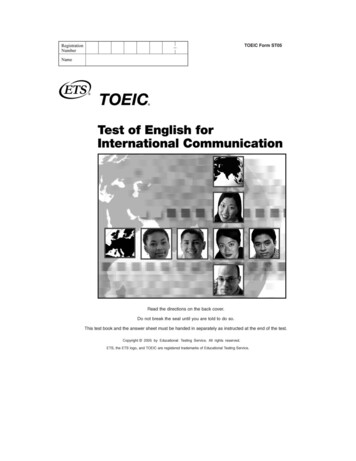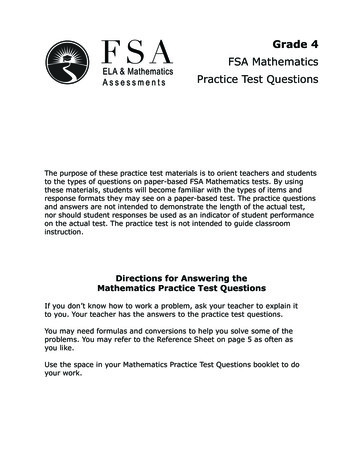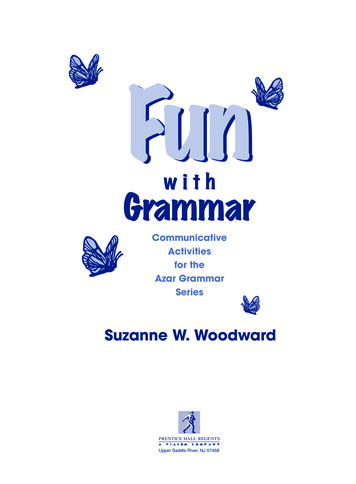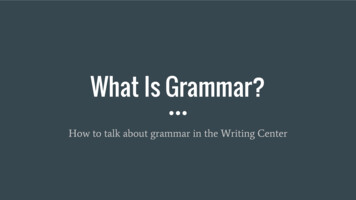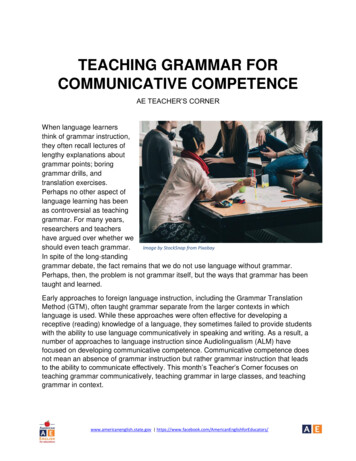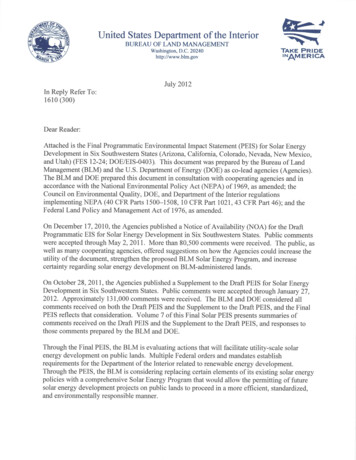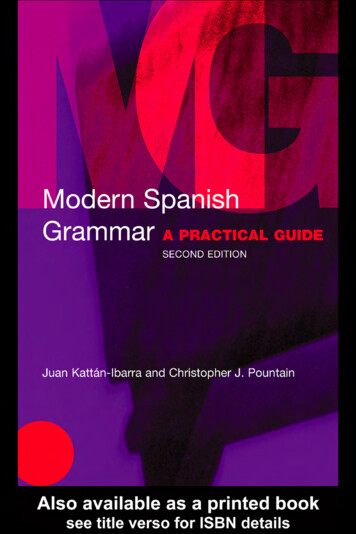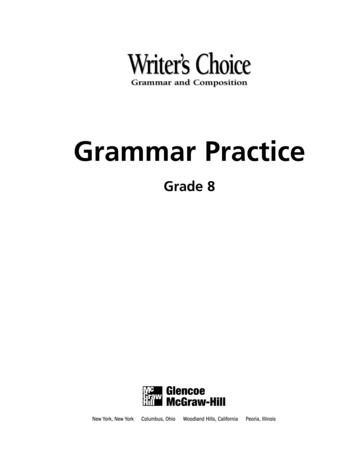
Transcription
Grammar and CompositionGrammar PracticeGrade 8
Glencoe/McGraw-HillCopyright The McGraw-Hill Companies, Inc. All rights reserved. Permission isgranted to reproduce material contained herein on the condition that such material bereproduced only for classroom use; and be provided to students, teachers, and familieswithout charge; and be used solely in conjunction with Writer’s Choice. Any other reproduction, for use or sale, is prohibited without written permission of the publisher.Printed in the United States of America.Send all inquiries to:Glencoe/McGraw-Hill8787 Orion PlaceColumbus, Ohio 43240ISBN 0-07-823347-X1 2 3 4 5 6 7 8 9 024 04 03 02 01 00ii
ContentsUnit 8Subjects, Predicates, and Sentences8.1–28.3–58.6Unit 9Sentences and Sentence Fragments. . . . . . . . . . . . . . . . . . . . . . . . . . . . . . . . . 1Subjects and Predicates . . . . . . . . . . . . . . . . . . . . . . . . . . . . . . . . . . . . . . . . . . 2Simple and Compound Sentences . . . . . . . . . . . . . . . . . . . . . . . . . . . . . . . . . 3Nouns9.1–2, 5 Kinds of Nouns . . . . . . . . . . . . . . . . . . . . . . . . . . . . . . . . . . . . . . . . . . . . . . . . 49.3–4Distinguishing Plurals, Possessives, and Contractions . . . . . . . . . . . . . . . . . . 59.6Appositives. . . . . . . . . . . . . . . . . . . . . . . . . . . . . . . . . . . . . . . . . . . . . . . . . . . . 6Unit ��12Unit 11Pronouns11.111.211.4–511.611.7Unit 12Personal Pronouns . . . . . . . . . . . . . . . . . . . . . . . . . . . . . . . . . . . . . . . . . . . . 17Pronouns and Antecedents . . . . . . . . . . . . . . . . . . . . . . . . . . . . . . . . . . . . . . 18Possessive and Indefinite Pronouns . . . . . . . . . . . . . . . . . . . . . . . . . . . . . . . 19Reflexive and Intensive Pronouns. . . . . . . . . . . . . . . . . . . . . . . . . . . . . . . . . 20Interrogative and Demonstrative Pronouns. . . . . . . . . . . . . . . . . . . . . . . . . 21Adjectives and Adverbs12.1–212.3–412.512.612.8Unit 13Transitive and Intransitive Verbs. . . . . . . . . . . . . . . . . . . . . . . . . . . . . . . . . . . 7Verbs with Indirect Objects. . . . . . . . . . . . . . . . . . . . . . . . . . . . . . . . . . . . . . . 8Linking Verbs and Predicate Words . . . . . . . . . . . . . . . . . . . . . . . . . . . . . . . . 9Present and Past Tenses. . . . . . . . . . . . . . . . . . . . . . . . . . . . . . . . . . . . . . . . . 10Main Verbs and Helping Verbs . . . . . . . . . . . . . . . . . . . . . . . . . . . . . . . . . . . 11Progressive Forms . . . . . . . . . . . . . . . . . . . . . . . . . . . . . . . . . . . . . . . . . . . . . 12Perfect Tenses . . . . . . . . . . . . . . . . . . . . . . . . . . . . . . . . . . . . . . . . . . . . . . . . 13Expressing Future Time . . . . . . . . . . . . . . . . . . . . . . . . . . . . . . . . . . . . . . . . 14Active and Passive Voice . . . . . . . . . . . . . . . . . . . . . . . . . . . . . . . . . . . . . . . . 15Irregular Verbs. . . . . . . . . . . . . . . . . . . . . . . . . . . . . . . . . . . . . . . . . . . . . . . . 16Adjectives, Articles, and Proper Adjectives . . . . . . . . . . . . . . . . . . . . . . . . . . 22Comparative, Superlative, and Demonstrative Adjectives . . . . . . . . . . . . . . 23Adverbs . . . . . . . . . . . . . . . . . . . . . . . . . . . . . . . . . . . . . . . . . . . . . . . . . . . . . 24Comparative and Superlative Adverbs . . . . . . . . . . . . . . . . . . . . . . . . . . . . . 25Avoiding Double Negatives. . . . . . . . . . . . . . . . . . . . . . . . . . . . . . . . . . . . . . 26Prepositions, Conjunctions, and Interjections13.113.213.313.4–513.7Prepositions and Prepositional Phrases . . . . . . . . . . . . . . . . . . . . . . . . . . . . 27Pronouns as Objects of Prepositions . . . . . . . . . . . . . . . . . . . . . . . . . . . . . . 28Prepositional Phrases as Adjectives and Adverbs . . . . . . . . . . . . . . . . . . . . . 29Conjunctions and Conjunctive Adverbs. . . . . . . . . . . . . . . . . . . . . . . . . . . . 30Finding All the Parts of Speech. . . . . . . . . . . . . . . . . . . . . . . . . . . . . . . . . . . 31iii
ContentsUnit 14Clauses and Complex Sentences14.1–214.3–414.514.6Unit 15Verbals15.115.215.3Unit 16ivCapitalization I . . . . . . . . . . . . . . . . . . . . . . . . . . . . . . . . . . . . . . . . . . . . . . . 43Capitalization II . . . . . . . . . . . . . . . . . . . . . . . . . . . . . . . . . . . . . . . . . . . . . . ��10AnswersUsing Troublesome Words . . . . . . . . . . . . . . . . . . . . . . . . . . . . . . . . . . . . . . 42Capitalization19.1–219.3–4Unit 20Making Subjects and Verbs Agree . . . . . . . . . . . . . . . . . . . . . . . . . . . . . . . . . 39Problems with Locating the Subject . . . . . . . . . . . . . . . . . . . . . . . . . . . . . . . 40Special Subjects . . . . . . . . . . . . . . . . . . . . . . . . . . . . . . . . . . . . . . . . . . . . . . . 41Glossary of Special Usage Problems17.1–3Unit 19Participles and Participial Phrases . . . . . . . . . . . . . . . . . . . . . . . . . . . . . . . . 36Gerunds and Gerund Phrases. . . . . . . . . . . . . . . . . . . . . . . . . . . . . . . . . . . . 37Infinitives and Infinitive Phrases . . . . . . . . . . . . . . . . . . . . . . . . . . . . . . . . . 38Subject-Verb Agreement16.1, 516.216.3–4Unit 17Sentences, Clauses, and Complex Sentences. . . . . . . . . . . . . . . . . . . . . . . . . 32Adjective Clauses. . . . . . . . . . . . . . . . . . . . . . . . . . . . . . . . . . . . . . . . . . . . . . 33Adverb Clauses . . . . . . . . . . . . . . . . . . . . . . . . . . . . . . . . . . . . . . . . . . . . . . . 34Noun Clauses . . . . . . . . . . . . . . . . . . . . . . . . . . . . . . . . . . . . . . . . . . . . . . . . 35Using the Period and Other End Marks . . . . . . . . . . . . . . . . . . . . . . . . . . . . 45Using Commas I . . . . . . . . . . . . . . . . . . . . . . . . . . . . . . . . . . . . . . . . . . . . . . 46Using Commas II . . . . . . . . . . . . . . . . . . . . . . . . . . . . . . . . . . . . . . . . . . . . . 47Using Commas III. . . . . . . . . . . . . . . . . . . . . . . . . . . . . . . . . . . . . . . . . . . . . 48Using Semicolons and Colons . . . . . . . . . . . . . . . . . . . . . . . . . . . . . . . . . . . 49Using Quotation Marks and Italics. . . . . . . . . . . . . . . . . . . . . . . . . . . . . . . . 50Using Apostrophes, Hyphens, Dashes, and Parentheses. . . . . . . . . . . . . . . . 51Using Abbreviations and Writing Numbers . . . . . . . . . . . . . . . . . . . . . . . . . 52. . . . . . . . . . . . . . . . . . . . . . . . . . . . . . . . . . . . . . . . . . . . . . . . . . . . . . . . . . . . . . . . . . . . . . . . 53
Grammar PracticeName . Class . Date .8.1–2Sentences and Sentence FragmentsKey InformationA sentence is a group of words that expresses a complete thought. Each sentence has asubject part that names whom or what the sentence is about and a predicate part thattells what the subject does or has. The predicate may also tell what the subject is or is like.There are four types of sentences: declarative, interrogative, exclamatory, andimperative.A sentence fragment is a group of words that lacks either a subject, a predicate, or both.A fragment does not express a complete thought. A. Identifying Types of SentencesDecide whether each item is a sentence or a sentence fragment. If it is a sentence, writewhether it is declarative, interrogative, exclamatory, or imperative, and add the correctend mark. If it is a sentence fragment, write fragment.1. I will be there by 8:15 in the morning2. Saving a seat for me3. Please be on time4. Ouch! I stubbed my toe5. What do you know about that speaker6. I can count on youCopyright The McGraw-Hill Companies, Inc.7. Pick up your books and go to the exit8. Can’t recall ever hearing a better speech B. Writing Complete SentencesCorrect the following fragments by writing them as complete sentences.1. At least once a week2. Definitely will not3. After school on the playground4. No one in the roomWriter’s Choice: Grammar Practice, Grade 8, Unit 81
Grammar PracticeName . Class . Date .8.3–5Subjects and PredicatesKey InformationThe complete subject includes all the words in the subject. The main word or group ofwords in the complete subject is called the simple subject. A compound subject has twoor more simple subjects with the same predicate.The complete predicate includes all the words in the predicate. The main word or group ofwords in the complete predicate is called the simple predicate. A compound predicatehas two or more simple predicates with the same subject. A. Identifying Subjects and PredicatesWrite whether each sentence has a simple subject or a compound subject and asimple predicate or a compound predicate. Then underline each simple subject andsimple predicate.1. Did you read and understand the homework assignment?2. She and Elizabeth will join us at the play.3. I know that lovely melody.4. You and I would rather eat apples and bananas.5. The boys jumped through hoops for us.6. Cowboys and cowgirls both rope steers.7. He huffed and puffed loudly.9. The author wrote and illustrated many books.10. She learned about physics and geometry. B. Making Subjects and Verbs AgreeUnderline the correct form of the verb in parentheses.1. John and Tanya (was, were) very upbeat.2. Parents and friends sometimes (shout, shouts) a lot at basketball games.3. Laughter (swell, swells) up in his chest and nearly (make, makes) him choke.4. She (write, writes) to her family each day.5. Peas and carrots (is, are) my favorite vegetables.2Writer’s Choice: Grammar Practice, Grade 8, Unit 8Copyright The McGraw-Hill Companies, Inc.8. Will you please rub my back?
Grammar PracticeName . Class . Date .8.6Simple and Compound SentencesKey InformationA simple sentence has one complete subject and one complete predicate. It may havea compound subject, a compound predicate, or both.A compound sentence contains two or more simple sentences joined by a comma anda coordinating conjunction or by a semicolon.A run-on sentence is two or more sentences incorrectly written as one sentence. Correcta run-on sentence by rewriting it as two separate sentences or by joining the sentenceswith a semicolon or with a conjunction preceded by a comma. A. Identifying Simple and Compound SentencesWrite whether each sentence is simple or compound.1. Tigers and elephants are my favorite zoo animals.2. Some animals live in cages, but these animals roam inside fenced areas.3. Tigers have such bright eyes; they look so intelligent!4. Elephants’ eyes are not so bright, but their eyelashes are long.5. Have you ever noticed the eye colors of elephants and tigers?6. Some animals enjoy being observed, but other animals seem uncomfortable.Copyright The McGraw-Hill Companies, Inc.7. Do you feel afraid, or do you find the experience enjoyable?8. Some zoo animals look happy; others seem depressed.9. Both elephants and tigers sometimes pace.10. Perhaps they are hungry or need some attention. B. Rewriting Run-on SentencesRewrite the following run-on sentences correctly.1. I told her yes then she ran up and put my name on the board.2. Her performance was fantastic, no one was better.3. I ate breakfast, she drank juice.4. I can’t possibly eat another thing okay, give me a carrot.Writer’s Choice: Grammar Practice, Grade 8, Unit 83
Grammar PracticeName . Class . Date .9.1–2, 5Kinds of NounsKey InformationA noun is a word that names a person,place, thing, or idea.A proper noun names a specific person,place, thing, or idea.BeatlesMontrealA common noun names any person, place,thing, or idea.childrenhonestyConcrete nouns name things you can seeor touch.deskchairAbstract nouns name ideas, qualities, orfeelings.honorsadnessCompound nouns are made up of two ormore words. To create the plural form ofhyphenated compound nouns and compound nouns of more than one word, add-s or -es to the most important part of thecompound.Commander in ChiefCommanders in ChiefA collective noun names a group that ismade up of individuals. A. Identifying Kinds of NounsList the nouns in each sentence. Then write whether each noun is proper, concrete,abstract, or compound.1. Did Oki see Maria’s new dog?2. I think it’s a golden retriever, but I’m not sure.4. Every Tuesday, she takes him to obedience school. B. Making Compound Nouns PluralFollow the rules you learned in your textbook to write a sentence using the correctplural form of each of the following compound nouns. Make sure the verb you useagrees with the noun. Use additional paper if necessary.1. (lawnmower)2. (son-in-law) C. Using Collective NounsFill in the blanks with an appropriate collective noun.1. The entire was at recess.2. The performers took a bow when the applauded.4Writer’s Choice: Grammar Practice, Grade 8, Unit 9Copyright The McGraw-Hill Companies, Inc.3. The truth is, she named him Goldy after her Aunt Golda!
Grammar PracticeName . Class . Date .9.3–4Distinguishing Plurals, Possessives, and ContractionsKey InformationPossessive nouns name who or what ownssomething. They can be singular or plural,common nouns or proper nouns. To formthe possessive of singular nouns and pluralnouns not ending in -s, add an apostropheand -s (‘s). To form the possessive of pluralnouns ending in -s, add only an apostrophe.the boy’s coatthe boys’ coatsBill’s coatthe Joneses’ carContractions are made by combining twowords into one and putting an apostrophein place of one or more letters.is not—isn’t A. Identifying Plurals, Possessives, and ContractionsWrite whether each underlined noun in the following sentences is a plural, a pluralpossessive, a singular possessive, or a contraction.1. The children’s books section of the store was packed with shoppers.2. I noticed that the catalog’s front page was ripped out.3. The bride’s never supposed to be late to the wedding.4. All five of the countries’ representatives spoke at once.5. That book’s the best one I’ve read this year.6. That singer’s sure to be a star someday.Copyright The McGraw-Hill Companies, Inc.7. The flowers’ fragrances were overwhelming.8. He wore several sweaters made of different styles and yarns. B. Using Plurals, Possessives, and ContractionsWrite three sentences for each of the following words. In the first sentence use theplural form of the word. In the second use the plural possessive form. In the thirdsentence use the word as part of a contraction.1. (child)2. (Frank)Writer’s Choice: Grammar Practice, Grade 8, Unit 95
Grammar PracticeName . Class . Date .9.6AppositivesKey InformationAn appositive is a noun that is placed next to another noun to identify it or add informationabout it.My only grandmother, Erma Clayborn, was a farmer.An appositive phrase is a group of words that includes an appositive and other words thatdescribe it.The man, a skilled athlete, easily lifted the heavy box. A. Punctuating AppositivesUnderline each appositive in the following sentences. Remember to add commasif needed.1. George Washington our first president had wooden false teeth.2. He and his wife Martha lived at Mount Vernon in Virginia.3. Martha a widow had children from her first marriage.4. Washington’s home Mount Vernon is open to the public.5. Martha Washington’s husband George was a farmer as well as a politicianand soldier. B. Writing Appositives1. Mrs. Fuller ran her best time ever in the 400-meter race.2. Our dog whimpered all night when we first brought him home.3. His father was also a very tall man.4. My cousin will stay for two weeks when she visits.5. Her teacher handed back the papers on time.6. She asked for her favorite hot drink.6Writer’s Choice: Grammar Practice, Grade 8, Unit 9Copyright The McGraw-Hill Companies, Inc.Rewrite the following sentences, and add appositives or appositive phrases to each.Be sure to punctuate your sentences correctly.
Grammar PracticeName . Class . Date .10.2Transitive and Intransitive VerbsKey InformationA direct object receives the action of a verb. It answers the question whom? or what? afteran action verb.When an action verb transfers action to a direct object, it is transitive.The crowd cheers the runners.When an action verb does not have a direct object, it is intransitive.The crowd cheers enthusiastically. A. Identifying Transitive and Intransitive VerbsThe following excerpt is from Growing Up by the American author Russell Baker.Indicate whether each of the underlined action verbs in the excerpt is transitive orintransitive by writing T or I in the space above the word. If the verb is transitive,underline the direct object twice.For the first time, light shone on a possibility. Writing couldn’t lead to a job afterhigh school, and it was hardly honest work, but Mr. Fleagle had opened a door forme. After that I ranked Mr. Fleagle among the finest teachers in the school. Mymother beamed with delight when I showed her Mr. Fleagle’s A-Plus and describedmy triumph.Copyright The McGraw-Hill Companies, Inc. B. Using Transitive and Intransitive VerbsWrite four sentences about someone you admire. Identify each action verb you use astransitive (T) or intransitive (I).1.2.3.4.Writer’s Choice: Grammar Practice, Grade 8, Unit 107
Grammar PracticeName . Class . Date .10.3Verbs with Indirect ObjectsKey InformationDirect objects are words that answer whom? or what? after an action verb.I wrote a letter.Indirect objects tell to whom or for whom an action is done. An indirect object appearsonly in a sentence that has a direct object.I sent mother the letter. A. Identifying Direct and Indirect ObjectsUnderline each direct object once, and underline each indirect object twice.1. I sang Tanya a song about happiness.2. She drank juice for breakfast every day.3. The glee club offers students an opportunity to sing.4. The dogs licked José in the face.5. Nick tossed Alicia a big, juicy apple.6. Each of the players knew the rules.7. The children loved the clown.8. Parents asked teachers many questions.9. The little girl ate a lollipop. B. Writing Sentences with Indirect ObjectsRewrite each sentence, underlining the direct object and adding an indirect object.1. She sang a song.2. The children made some candy.3. This magazine offers fashion tips.4. The teacher gave the tests.8Writer’s Choice: Grammar Practice, Grade 8, Unit 10Copyright The McGraw-Hill Companies, Inc.10. The little boy gave his mother a drawing.
Grammar PracticeName . Class . Date .10.4Linking Verbs and Predicate WordsKey InformationA linking verb connects the subject of asentence with a noun or an adjective inthe predicate.The dog was friendly.A predicate noun is a noun that followsa linking verb. It tells what the subject is.She is a teacher.A predicate adjective is an adjective thatfollows a linking verb. It describes the subject by telling what it is like.The sky is cloudy.Some common linking verbs are forms ofthe verbs be, become, smell, look, feel,sound, grow, taste, and appear. A. Identifying Linking Verbs and Predicate Nouns and AdjectivesUnderline the verb in each sentence, and label it action or linking. If the verb is alinking verb, write whether it is followed by a predicate noun or a predicate adjective.1. Grandmother always grows lavender.2. Today I feel wonderful!3. Mrs. Johnson is our coach.4. Craig is always organized.5. Sandy clearly was the leader.6. Professor Hayford conducted experiments.Copyright The McGraw-Hill Companies, Inc. B. Using Linking Verbs and Predicate Nouns and AdjectivesWrite a sentence for the given topic, using a form of one of the following linking verbsin each sentence: smell, sound, feel, taste, grow. Use at least one predicate noun orpredicate adjective in each sentence.1. (difficulty or ease of writing)2. (breakfast food)3. (flower garden)4. (sunshine)Writer’s Choice: Grammar Practice, Grade 8, Unit 109
Grammar PracticeName . Class . Date .10.5Present and Past TensesKey InformationThe present tense of a verb names an action that happens regularly. It can also express ageneral truth.The mail arrives at 1:00 P.M.The past tense of a verb names an action that already happened.Yesterday the mail arrived late. A. Distinguishing Between Verbs in Past and Present TenseRead the following paragraph, and decide whether each numbered, underlined verbis written in the present tense or in the past tense. Write your answers in the spaceprovided below the reading selection.1.5.2.6.3.7.4.8. B. Writing Verbs in Present and Past TensesWrite two sentences each for the verbs jump and walk. Follow the guidelines inparentheses.1. (present tense)2. (past tense)3. (present tense)4. (past tense)10Writer’s Choice: Grammar Practice, Grade 8, Unit 10Copyright The McGraw-Hill Companies, Inc.Fish, flowers, and landscapes (1.) are the subjects of paintings by Joseph Raffael,a California painter. Raffael (2.) experimented with color and light in many of hisworks. (3.) Examine his paintings. They (4.) have very bright colors. In the paintingJoseph and Reuben, which he (5.) painted in 1984, Raffael (6.) used a strong contrastbetween darkness and light. This technique (7.) is different from that in his otherpaintings. It (8.) gives the painting the look of a snapshot.
Grammar PracticeName . Class . Date .10.6Main Verbs and Helping VerbsKey InformationA helping verb helps the main verb tell about an action or make a statement. Commonhelping verbs are be, have, and do.A verb phrase consists of one or more helping verbs followed by a main verb.They are running together in the race. A. Using Helping Verbs CorrectlyCircle the correct helping verb in parentheses.1. Wilma (had/have) hoped that we’d go with her.2. Some people (are/have) arrived already.3. Kids (are/were) lined up around the block yesterday.4. The pitcher (is/has) finally arrived to start the game.5. The ushers (had/were) already seating the crowd. B. Practice with Helping and Main VerbsIn sentences that are questions, the helping and main verbs of a verb phrase are notplaced next to one another. Rewrite the following sentences, changing them intoquestions if they are statements and into statements if they are questions.1. She has developed all the film I sent her.Copyright The McGraw-Hill Companies, Inc.2. André has sat at the same desk all year.3. Had she joined them before they left for school?4. Mrs. Watkins is handing back the papers.5. Were you watching the football game?Writer’s Choice: Grammar Practice, Grade 8, Unit 1011
Grammar PracticeName . Class . Date .10.7Progressive FormsKey InformationThe present progressive form of a verb names an action or condition that is continuing inthe present.He is going. [singular]We are going. [plural]The past progressive form of a verb names an action or condition that continued for sometime in the past.She was exploring. [singular]We were listening. [plural] A. Using Present and Past Progressive Verb FormsIn sentences 1–3, write the present progressive form of each underlined verb phrase.In sentences 4–6, write the past progressive form of each underlined verb phrase.1. They were singing outside our door.2. I was laughing very hard!3. They were jumping over the puddle together.4. They are studying the breakup of the Soviet Union.5. William is racing me to the corner.6. Sylvia is questioning me about politics.Write three sentences using the present progressive form of a verb. Use one of thesehelping verbs with the main verb in each sentence: am, are, is. Write two sentencesusing the past progressive form of a verb. Use the helping verbs was and were.1.2.3.4.5.12Writer’s Choice: Grammar Practice, Grade 8, Unit 10Copyright The McGraw-Hill Companies, Inc. B. Writing Present and Past Progressive Verb Forms
Grammar PracticeName . Class . Date .10.8Perfect TensesKey InformationThe present perfect tense of a verb names an action that happened at an indefinitetime in the past. It also tells about a past action that happened in the past and may stillbe happening.The dogs have barked for hours.The dogs have been barking all day.The past perfect tense of a verb names an action that happened before another actionor event in the past.He had just sat down when the music began. A. Using the Present Perfect TenseChange each verb to the present perfect tense.1. We watch2. They smell3. He wonders4. You touch5. She swallows6. I wantCopyright The McGraw-Hill Companies, Inc. B. Using the Past Perfect TenseWrite five sentences using the past perfect tense of each of the following verbs: tape,mow, dance, wrap, rip.1.2.3.4.5.Writer’s Choice: Grammar Practice, Grade 8, Unit 1013
Grammar PracticeName . Class . Date .10.9Expressing Future TimeKey InformationFuture tense tells that something will happen in the future. The future tense of a verb isformed by adding the helping verb will before the main verb.Joe will play the piano.Time words can also be used with the present tense and present progressive form to showthat an action will happen in the future. Examples of time words are soon, next month,and tomorrow.Tomorrow we leave for vacation.Later we are eating dinner.The future perfect tense names an action that will happen before another future eventbegins. The future perfect tense is formed by adding will have before the verb’s past participle.As of Friday, I will have worked nonstop for a week. A. Expressing Future TimeRewrite each sentence on a separate sheet of paper, using the correct form of the verbin parentheses to express future time. Use either the future, the future perfect, thepresent, or the present progressive form. Then identify the tense of the verb you used.1. Tomorrow morning, please (wake) me at nine o’clock.2. Soon I (be) fifteen years old!3. Dora (attend) the meeting. B. Writing in Future TimeUse each verb in a sentence of your own. Follow the guidelines given in parentheses.1. (enter; future perfect tense)2. (practice; future tense)3. (present; future tense with time word)4. (sniff; present progressive form with time word)14Writer’s Choice: Grammar Practice, Grade 8, Unit 10Copyright The McGraw-Hill Companies, Inc.4. By this time next month, I (complete) the project.
Grammar PracticeName . Class . Date .10.10Active and Passive VoiceKey InformationIn the active voice the subject performs the action of the verb.My uncle milked the cow.In the passive voice the subject receives the action of the verb.The cow was milked by my uncle. A. Changing Active Voice to Passive VoiceRewrite each sentence to express passive voice.1. Eliza won first place in the marathon.2. Several friends admired my new bike.3. I broke the window last week.4. My friend patted me briskly on the shoulder.5. The singer created excitement wherever he went.Copyright The McGraw-Hill Companies, Inc. B. Changing Passive Voice to Active VoiceRewrite each sentence to express active voice.1. The contest was won by a girl from another school.2. Clara was driven to school by her mother.3. Good deeds are performed by the Brownies.4. The bread was baked by John, Michael, and Erin.5. Eyes are examined by optometrists.Writer’s Choice: Grammar Practice, Grade 8, Unit 1015
Grammar PracticeName . Class . Date .Irregular Verbs10.11–12Key InformationIrregular verbs are v
2 Writer ’s Choice: Grammar Practice,Grade 8, Unit 8 A. Identifying Subjects and Predicates Write whether each sentence has a simple subject or a compound subject and a simple predicate or a compound predicate
